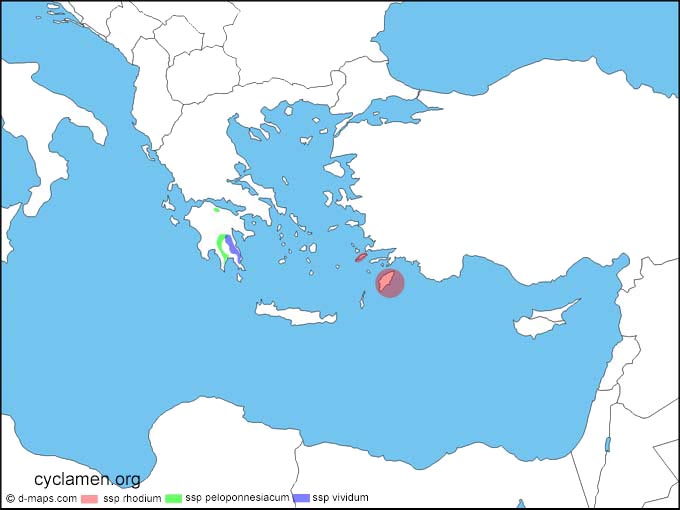Description
Flowers appear in spring, in the wild from March to May, ssp rhodium – white to occasionally very pale pink with a pale pinkish-purple nose, a pure white form is known in the wild, ssp peloponnesiacum – pale to deep pink with a darker reddish pink nose, a pure white (forma albiflorum) is known in the wild, ssp vividum – dark reddish-pink with an even darker reddish-purple nose, a white form is known in the wild. All subspecies are fragrant with a sweet scent. The corolla lobes are reflexed, 15-30mm long, 5-10mm wide, with pointed tips generally 180 degrees twist, no auricles at the base.
Leaves appear in early spring, full grown by flowering time, thin blade, oval to triangular, edges faintly lobed often with scalloped margins, dark or grey green background with pale green, grey-green or silver markings, from a jagged zone or patches around a dark central triangular area to random splashes all over the surface, underside pale green or purplish, 2-15cm long, 1.5-15cm wide.
Tuber
Tuber a compressed sphere, medium sized at maturity, up to 7cm diameter, brown, smooth, with fine velvety hairs, becoming rough with age, branching thin (0.5mm) diameter roots arise from the centre of the underside.
Distribution
Cyclamen rhodium ssp rhodium grows on the Eastern Aegean islands of Rhodes and Kos. Cyclamen rhodium ssp peloponnesiacum grows in the eastern, northern and (the main area) central southern (Mani peninsula) Peloponnese. Cyclamen rhodium ssp vividum grows in the eastern southern (Parnon mountains) Peloponnese, overlapping in the north of its range with ssp peloponnesiacum.
Habitat
Cyclamen rhodium ssp rhodium grows in shade under scrub and in rocky areas, often in pine forest, from 50-800m; ssp peloponnesiacum grows in humid, shady places in woodland, scrub and at cliff bases, from 350-1500m; ssp vividum grows in drier, open places in light woodland, rocks and scrub from 400-1700m.
Cultivation
Cyclamen rhodium subspecies are not particularly hardy but when planted deeply, 10-15cm, in a sheltered and damp (not wet) situation, could make a good garden plant in milder parts of northwest Europe. In colder climates they grow well as pot plants in a frost-free greenhouse, performing best when well shaded, although ssp vividum will take more sun. No cultivars have been named. ‘Pelops’ was a name given to ssp peloponnesiacum when this was considered part of the C. repandum group. Pure white flowered plants and those with leaves with brighter patterning, including an all over silver wash, are often grown. In cultivation ssp peloponnesiacum has hybridised with the closely related C. balearicum (C. x saundersiae) and, since C. creticum, C. repandum and all the subspecies of C. rhodium, which are geographically separated in the wild, have the same chromosome number, hybridisation among them is likely.

Cyclamen rhodium subsp. rhodium.

Cyclamen rhodium subsp. rhodium southwest of
Embonas, Rhodes.
Cyclamen rhodium subsp. rhodium, subsp. peloponnesiacum and subsp. vividum
Cyclamen rhodium subsp. rhodium is endemic to the northern half of the eastern Aegean Greek island of Rhodes and the southern tip of nearby Kos. The flowers of subsp. rhodium are usually white or occasionally very pale pink, with a pale pinkish-purple nose. An entirely white-flowered variant has been found in nature but has not been named.
A woodland plant, often found growing in deep pine needle litter (or fallen plane tree leaves) with the tuber sitting on the surface of the soil under the pine needles. Also seen growing along stream banks, even below where the water level would be in winter months.

Cyclamen rhodium subsp. peloponnesiacum.



Cyclamen rhodium subsp. peloponnesiacum f. albiflorum
Cyclamen rhodium subsp. peloponnesiacum is found in the Greek Peloponnese to the west of the Parnon Mountain range and in the northern Peloponnese. Subsp. peloponnesiacum has very pale to rose-pink fragrant flowers with a darker reddish pink to magenta nose. On some flowers the corolla lobes are a somewhat darker pink towards their tip. An entirely white-flowered albino form has been found in nature and named Cyclamen rhodium subsp. peloponnesiacum f. albiflorum.
Usually found in damp shady places, but not unknown in more open situations where it gets more sun such as on roadside banks at the edge of woodland or low scrub. It appears happiest in broad-leaved woodland in areas that are quite wet to the extent of being boggy.

Cyclamen rhodium subsp. vividum.

C. rhodium subsp. vividum CSE93227 between Leonidi
and Vaskina.
Cyclamen rhodium subsp. vividum is endemic to the Greek Peloponnese where it grows on the eastern and southern sides of the Parnon Mountain range. There is also a small population on the island of Kythera just south of the Peloponnese. The fragrant flowers of subsp. vividum are a deep glowing ruby red in the best plants, though mid-pink colours are known. There is a basal blotch on the nose but this is often hardly noticeable as it differs very little from the main colour of the flower. An entirely white-flowered variant has been found in nature but has not been named.
Often found growing in light open woodland, but also in more open rocky areas, which become quite dry in summer.










